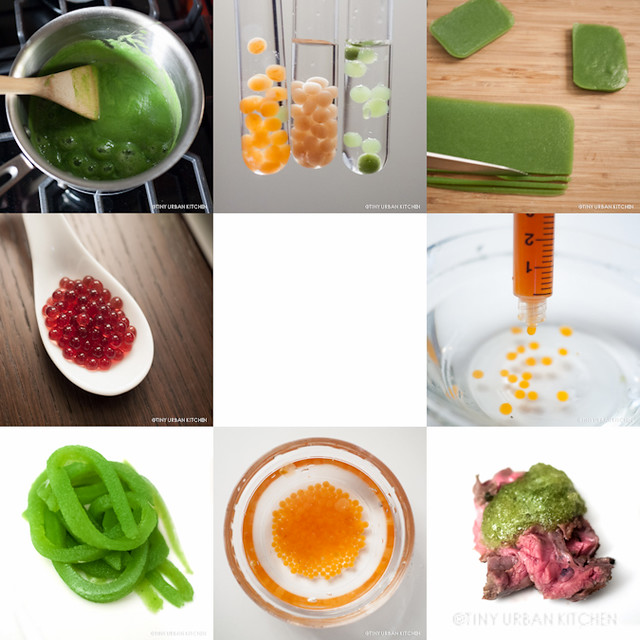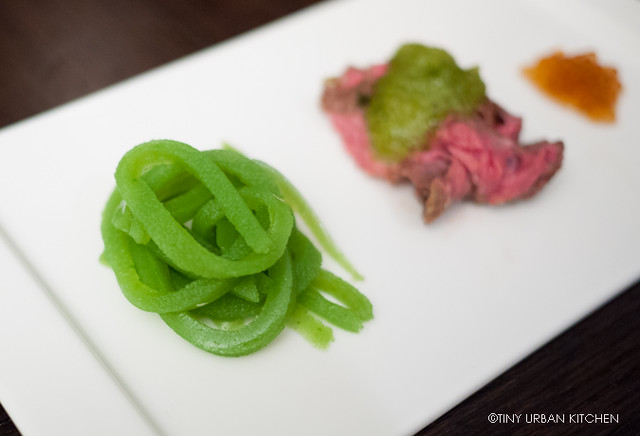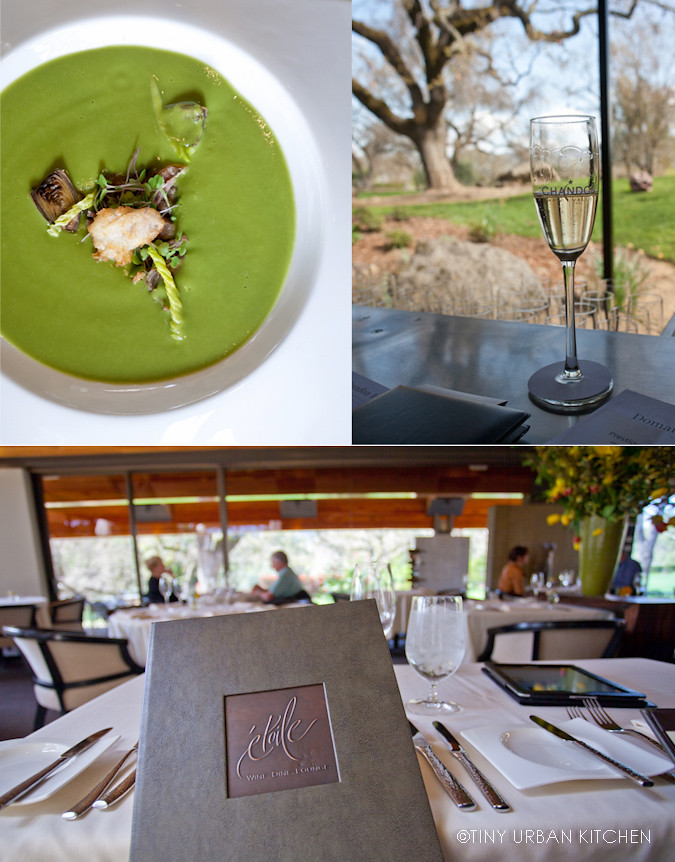
I never thought I'd say this.
But, I actually miss the lab.
It's been years since I've touched a syringe, weighed out powders, or set up chemical reactions. Before law school, I worked for years as a synthetic research chemist making new molecules that could potentially become medicines. There was always a sense of excitement in trying to make something that had never been done before, hoping to find the next breakthrough.
This past weekend, the inner chemist in me finally got a chance to play.
Friends of mine gave me a molecular gastronomy set from Artistre for my birthday last fall. I can't believe it's taken me this long, but I finally cracked open my multiple bags of powders and began experimenting this weekend.
I had so much fun! All afternoon I read voraciously on the science behind techniques such as spherification, gels, and foams. I set up several "reactions", "purified" end products, and ran many test experiments.
The final result? A four-course meal consisting of various classic Asian dishes, re-interpreted with molecular gastronomy.
Course 1: Pho + Sauce

Pho is a traditional Vietnamese noodle soup that consists of an aromatic broth, meat (usually beef or chicken), and rice noodles. It is usually served with bean sprouts, Asian basil, mint, and fresh lime wedges as accompaniments on the side. Additionally, a pho meal would be incomplete without the two fundamental sauces: Sriracha (a spicy chili sauce) and hoisin (a sweet bean sauce).
My modern, "molecular" interpretation of this dish took all of the elements from traditional pho but presented them in vastly different ways.
Part 1: "Pho"

Lime, mint, and cilantro marinated skirt steak over Pho rice noodles tossed in an Asian basil pesto

I marinated skirt steak in lime, mint, cilantro, and chili peppers, all classic flavors associated with pho.

I also added soy sauce and fish sauce to round out the flavors of the marinade. For a modern twist, I cooked this steak sous-vide for about three hours before quickly searing the steak on a hot grill.
The end result was absolutely delicious, juicy and full of those wonderfully fragrant Southeast Asian flavors.
Sweet Basil Pesto

For the pesto, I combined Asian basil, garlic, salt, and oil in a food processor. I tossed the pesto with traditional rice noodles used in pho. The resultant pesto is aromatic, herbaceous, and peppery.
Part 2: Sauce

Typically at a Vietnamese restaurant, the tables will already be set with a container full of chopsticks, a napkin dispenser, and several bottles of sauces. Classic sauces you see with pho include a sweet, dark bean sauce (hoisin sauce) and a red hot spicy sauce (Sriracha - yes the famous one with a rooster on it).

I used a technique called spherification to make balls of hoisin sauce, cilantro essence, and Sriracha sauce. Spherification involves mixing your "juice" or "sauce" of choice with Sodium Alginate and then "pipetting" out small bubbles into a basic Calcium Chloride bath. You can then use your nifty hot pot scooper to gently fish out the balls, which you rinse with water before serving.
Putting It All Together

Using a mold (we used a cookie cutter kind of like this), layer the pesto noodles and top with slices of grilled steak. Remove the mold. Add the three different flavored "caviars" on the other side.
Course 2: Deconstructed Taiwanese Beef Noodle Soup

I've made traditional Taiwanese beef noodle soup before (yes, I even hand-pulled the noodles). A traditional Taiwanese beef noodle soup is made by stewing beef shank in a rich soy-based broth infused with spices such as star anise, hot bean paste, and chili sauce. This gorgeous beef "stew" is served with noodles and vegetables (for example, bok choy).
Bok Choy "Noodles"

For this meal, I decided to be a bit more creative with the presentation. Instead of traditional noodles, I decided to take the bok choy element of the dish and make that into noodles instead.

I blended bok choy, dashi broth, and shallots into a puree, and then cooked it with agar agar and some salt.

It only took about an hour at room temperature before they set.

Finally, I cut them into "noodles" and served them alongside the other two elements.

Cilantro Foam

Cilantro is one of Bryan's favorite herbs, and it's often served as a garnish for beef noodle soup. Foams have become popular in the molecular world because they can infuse the pure essence of a flavor without dilution by anything else, except air.

I made a foam by first steeping cilantro in hot water before blending the mixture to create a cilantro liquid. I then added gelatin powder + water to the liquid (as a stabilizing agent) before incorporating air into the liquid with my favorite immersion blender.

This foam can stay intact in the refrigerator for a couple hours, although eventually it starts losing some structure.
I used the foam as a topping for the steak, but you can use it in all sorts of different applications.
Beef Soup "Caviar"

I made normal beef noodle soup and spherified the broth using the same spherification method described above.

As an alternate preparation, you can just enjoy a simple bowl of the spicy beef soup with the bok choy noodles.
Put it all together

Course 3: Vanilla Bean Panna Cotta with Matcha Spheres

Although the use of gelatin does not seem nearly as novel as some of these more modern methods, I still think of using gelatin as a form of rudimentary molecular gastronomy. After all, you're still adding a powder to some food and changing its structure, right?

Panna Cotta is a classic Italian dessert that uses gelatin instead of eggs to create a sort of "custard" from cream.

Panna Cotta is so easy to make (it's just like jello but with cream!) yet easily impresses guests because it looks so elegant and tastes so darn delicious. You can infuse any sort of creative flavors you want into the cream + gelatin mixture (for example, I used fresh vanilla beans). Pour the creamy liquid into cups (like tea and coffee cups) and let cool overnight in the refrigerator.

To add both an Asian and molecular twist, I made matcha spheres using the same spherification method described above. Put a few matcha pearls on top of the panna cotta and enjoy with a nice sauterne.
Course 4: After Dinner Drinks

Just for fun, we tried spherifying a few wines and spirits to see how they would taste. Surprisingly, the chemical reactions involved in spherification affect different types of drinks differently. Spherified scotch whisky lost a lot of its sweet and floral notes yet maintained a strong "peaty" characteristic.

Spherified Chateau La Tour Carnet
Spherified red wine, on the other hand, lost its deep tannins and instead became much more fruity and light. The Cabernet part of this blend seemed to disappear while the Merlot portion became more pronounced.
Epilogue

Jen on her last day of work as a chemist
It was a wild and fun weekend, full of interesting challenges and surprises. In many ways, working in my kitchen "lab" this weekend reminded me a lot of my past life in the lab. I weighed out powders; I stirred interesting liquids; I tested a variety of "conditions;" and I wrote copious notes.
However, there was one huge difference.
Never in the chemistry lab could I ever taste my final product.
That's priceless.

Please note that I was not able to put all of the recipes for all of these cool dishes into this one post (it would have been way to unwieldy). I plan on posting individual recipes for most of these dishes this coming week, so stay tuned!
Update: Links to the recipes
Bok Choy Noodles
Sweet Basil Pesto with Rice Noodles
"Pho" Grilled Steak with Mint, Cilantro, and Lime
Spherification
Vanilla Bean Panna Cotta with Matcha "Caviar"
Cilantro Foam
Thanks Foodbuzz for sponsoring this meal as part of Foodbuzz 24, 24!






















